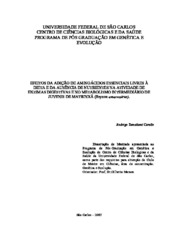Efeitos da adição de aminoácidos essenciais livres à dieta e da ausência de nutrientes na atividade de enzimas digestivas e no metabolismo intermediário de juvenis de matrinxã (Brycon amazonicus)
Abstract
For the nutrients ingested by fish are used for growth and maintenance of the
energetical metabolism, they need firstly being absorbed by gastrointestinal tract. However,
the most foods ingested cannot be absorbed directly through the gastrointestinal mucosa,
since they are largely formed by high molecular weight molecules. The process of
transforming large molecules into smaller is catalyzed by digestive enzymes. Therefore, a
limiting factor to the food absorption is the availability of those enzymes. Their synthesis and
the secretion can be stimulated by free amino acids in the gastric and intestinal lumen.
We have investigated the effect of free essential amino acids (AAEL) supplementing
the diets on the synthesis of digestive enzyme and the intermediary metabolism of matrinxa.
Six fish groups were submitted to different feeding condition for 15 days. The control group
was fed with 34% of protein and 4.670 kcal of gross energy by kg of food. Maize starch and
soy oil were used as energy source. The second group, called SO, was fed with casein and
gelatin as protein source and maize starch as energy source. The third group, called
SO+AAEL, was feed with a similar food wherein the 0.6% of cellulose, added as inert stuff,
was replaced by a mixture conteining 0.1% of phenylalanine, 0.1% tryptophane, 0.1% valine,
0.1% histidine, 0.1% arginine and 0.1% leucine. The fourth group, called SA, was feed with
casein and gelatin as protein source and soy oil as energy source. The fifth group, called
SA+AAEL, was feed with a similar food but 0.6% of cellulose was replaced by a mixture of
six AAEL, just as above. The last group was kept in fast over the experimental period.
After the experimental period, 9 fish from each treatment were sampled. The blood
was withdrawn and white muscle, liver and digesting treat were excised. The amylolytic,
proteolytic and lipolytic activities assayed in digestive tract homogenates were responsive to
diet composition, mainly to the absence of starch and the addition of FEAA. The present set
of data indicates that the matrinxa is able to adjust these enzymes production toward digestive
process optimization.
The alterations in plasmatic, muscular and hepatic metabolic intermediaries
concentration become evident that the matrinxa is able to adapt its intermediary metabolism to
the changes on the feeding condition to preserve vital functions. However the increase of the
enzymatic activity in the fed with the diet AAEL did not result in significant modification on
the intermediary metabolism.
